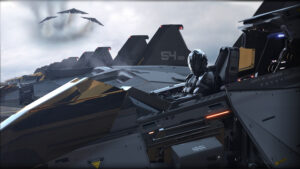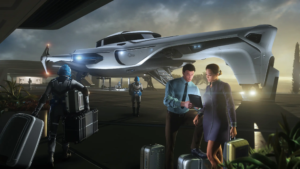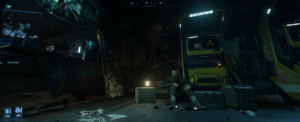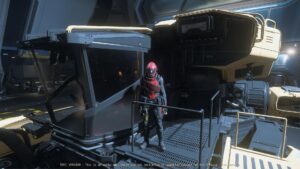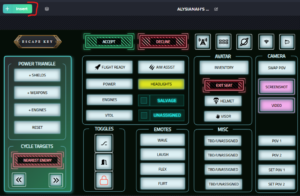[vc_row][vc_column width=”2/3″][vc_column_text]
Show Transcript
Welcome to another episode of Casual Citizen. An on-going series about the upcoming first person MMO Star Citizen by Cloud Imperium Games. I’m your host Alysianah from the Mystic Worlds Gaming Blog.
Sorry about the two-week hiatus. Between work, a business trip and being offered an exciting opportunity to narrate a small audiobook, I’ve been rather overloaded. I was at least spared the agony of watching the pot boil for 2.4 hitting the Live Server. Here’s hoping it’s not too far off.
This week’s episode will discuss another ship that’s near and dear to my heart, the Drake Herald. It’s one of only three small career ships in my line-up. The fact that I can own platform ships, ships for medium sized groups AND engage in solo or duo activities, is a huge part of what excites me about Star Citizen. I like the flexibility to control my playstyle and/or dependency on other players to fit my mood or what I feel like accomplishing at any given time. In looking at the Herald, we’ll touch on Drake as a company, the Magnus System where they’re headquartered and Electronic Warfare, as it relates to the Herald.
BEGIN TRANSMISSION
Most players would likely agree, that the Herald isn’t the prettiest or sleekest ship in the ‘verse. Some consider it downright ugly. For me, it falls into the so quirky that it’s cute category. I find it attractive in a crooked smile kinda way. And although I preferred the original asymmetrical design, I’m not bothered by the change in direction. Those were concept images. This is alpha. Shit happens…Yadda. Before delving into the Herald, let’s take our first look at its manufacturer, Drake Interplanetary.
For many citizens, the name Drake Interplanetary conjures up images of ships whose silhouettes don’t look aerodynamically balanced. And the ne’er-do-wells and criminals flying them. Pirates. Drake hasn’t helped change this perception by naming its ships things like Cutlass and Buccaneer. And their the cheesy billboards featuring an overly endowed woman, dripping sex appeal all over the newest starfighter they’re showcasing, doesn’t help much either. When you’re not seeing Drake’s in-your-face adverts, it’s yet another newsvid about investigations into their criminal ties.
Drake’s keystone design is the Drake Interplanetary AS-1 Cutlass. Incredibly inexpensive, Drake Cutlasses are used across the galaxy for thousands of different roles. From search and rescue ambulances to mining prospector conversions, to short hop food transports. The modular nature of the Cutlass means it can be anything to anyone. Including those skirting the law.
Beyond its modularity, the Cutlass’ claim to fame is that it’s built from common parts. This makes it an affordable ship to replace for those who are living a lifestyle that no longer offers the benefit of purchasable insurance. Drake Interplanetary incorporated soon after the success of the Cutlass. Lead designer Jan Dredge became CEO, with a seven-member board, consisting largely of aerospace engineers who had worked on the project.
Drake is not the surname of anyone involved in the project; it was selected as an acceptable “smooth-sounding” name, chosen specifically in the hopes that it would make their spacecraft more appealing. This was the first of a series of money-over-all decisions that would quickly come to define the company.
Another factor that swaying the UEE’s belief that Drake is in some fashion associated with criminal activity, was their decision to locate their corporate headquarters and key factories on Borea in the Magnus system. At the time, Magnus was a desolate and lawless system, peppered with ghost towns and people living on the fringe of the space frontier. Locating on Borea, was yet another seed planted in the garden of their outlaw image. Regardless of the UEE’s assumptions or those of more polite society, within five years Drake was the fifth largest spacecraft manufacturing concern.
However, with the Galaxy in a relative level of peace, or as close to peace as it had ever been – Vanduul raids at the time were disorganized and the UEE military was in the middle of several years stand down. Who was buying thousands upon thousands of Cutlasses? The answer, of course – pirate organizations. The affordability of Drake ships created readily replaceable spacecraft that fit a pirate’s budget, and thanks to its larger-than-average cargo hold, they could also transport pirate booty.
It eventually became clear, though not publically acknowledged, that Drake had made a deal with the devil … but the money was too good to turn back. It’s rumored that in looking toward future, CEO Dredge is authoring a plan to streamline their spacecraft lineup and clean up the company’s image. A daunting task for the modular, boxy Cutlass, Caterpillar, and Buccaneer! And then there are those ship names. Only time will tell.
Life in Magnus
Directly from CIG
“Magnus: On the Edge of the Unknown!” or so reads the local government’s standard travel brochure. In truth, the phrase better describes Magnus a century ago; recent decades have seen increasing settlement and overall civilization in a system that considers itself the unofficial capital of Human frontier culture.
End Quote
First discovered in 2499, Magnus was a small, entirely undistinguished system: three planets orbiting a type K main sequence star. Dimmer than Earth’s own sun, Magnus did not have the pull to generate a system of outer planets or an extensive network of jump point tie-ins. Surveys have located no protoplanets, gas pockets or asteroid fields in the system’s environs; the area surrounding Magnus is the deepest, most desolate space imaginable. A single world, Magnus II, was identified as ideal for terraforming.
For a time, Borea – Magnus II, was a barren desert world — the effects of terraforming had not yet completely transformed the planet, and a ten-year period of extreme solar flares hampered its transition to a temperate world. This increased the decay of the UEE facilities and generally reduced overall interest in resettling Magnus. The result was an eerie, depopulated ghost world with declining structures full of refining and shipbuilding equipment considered too expensive to move elsewhere. During this period, the system’s population declined to less than 3,000, most of whom had no legal right to their encampments.
Let’s step back for a moment to consider living on a planet whose entire population is 3000 inhabitants. It has to feel something like living in a post-apocalyptic world. Or being on a backwater border planet in FireFly, where Jayne is worshiped as a deity. I think I’ll pass but Drake said sure, sounds good!
Drake’s decision to locate the headquarters and primary factories on Borea eventually helped to revitalized the landscape. Vast tracts of empty warehouses and rusting construction yards have been modernized and returned to life from building Cutlasses and Caterpillars. All’s well that ends well and good on Drake. But personally, I’d have started job hunting when the news came around about where the offices were going.
The Drake Interplanetary Herald
Overview
The original concept sale for the Herald was November 2014. The Herald is a small armored ship, designed to safely deliver information and you, from one place to the next. Its speed will rival racers but it won’t have the same nimble handling. It has a powerful central engine to support advanced data encryption. It also sports data protection systems, redundant power subsystems, EMP shielding and high capacity broadcast arrays for data transmission. In a nutshell, it’s spec’d to acquire rare data, encrypt/protect it, escape with said data and/or transmit it to your cohorts. As a fallback, it has a quick method to clear your drives of evidence, in case you get caught in the act or hijacked.
Ship Configuration
Classified has Info Runner. Is 23 meters in length and weighs 18 thousand kilograms. Supports 2 crew stations and 0 cargo units. For hardpoints, it’s configured with 3 S1 gimbal mounts, an S3 shield, and one additional equipment mount.
A bit of Drake related fiction from RobertsSpaceIndustries.com…
Dispatch: A New Threat to Data Security by Drake Interplanetary
SUBJECT: DRAKE HERALD DATA
STATUS: URGENT
Attention Team,
Attached to this dispatch are the final specifications and 3D holo-model of what you have worked all these long months to accomplish! Our Herald prototype will now enter the construction and testing phase, with a planned Q2 2945 rollout for the first sales units.
On the surface, the Herald represents a significant advance in interstellar data transfer… but as we Drake team members know, its long-term implications for data interception, stream interruption, and even outright piracy are enormous. I’m proud of everything we’ve accomplished, and now I can’t wait to see this baby fly!
Becke Linns
Senior Spacecraft Designer
Drake Interplanetary
END QUOTE
In that final paragraph, we can see that Drake’s intention of cleaning up their act is only surface level. A little spit-n-shine for the ole public image. Clearly, they understand and acknowledge the potential ramifications of their designs!
Quick Chat about Electronic Warfare
In August of 2015, CIG published a design document discussing their plans for implementing Electronic Warfare, often abbreviated to EWAR. EWAR mechanics played such a heavy role in EVE Online combat, I’ve been very interested in learning more about how it would play out in Star Citizen. Oftentimes in EVE, you can lose a fight before you’ve undocked from a station, simply by not having your ship adequately configured for an encounter. Will EWAR in Star Citizen has the same far-reaching impacts? It will be quite some time before we can answer that question.
Let’s review the portion of the Star Citizen EWAR Design Document that speaks to capabilities we can expect to see incorporated into the Herald, as an interceptor of information.
Radar (Object-Detection) and Scanning
The Drake Herald is an information runner but includes a dedicated e-war suite, which includes the ability to scan. Scanning is the tracking or gathering of information based off of the three main signature outputs: Infrared, Electromagnetic, and Cross-section.
Every ship has a suite of default systems that give it basic operational functionality. Our radar systems use IR, EM, or radio waves to determine the range, angle, and velocity of objects. Standard operating mode for radar systems is omnidirectional. However, players with the right equipment can change the focus of their unit. Changing the focus increases the transmit power, but reduces the area in which targets can be located.
Scan and radar effectiveness are also impacted by the environment. For example, solar radiation from the nearby star could wreak havoc on your results. The goal is to introduce variance in performance between radar components and require choices from the player, as to what type of information they value above others, as well as reduce the time of a scan and/or the risk of being detected.
Players will be able to scan their surroundings either passively or actively.
- Passive – The player is letting the information come to them versus actively searching for the information (in essence listening). This emits a much smaller signature.
- Active – The player’s ship is actively looking for information about their ship. This emits a much higher signature.
In passive scanning, the range and detection type are based on the radar component that your ship has installed. Any potentially targetable object within your ship’s radar zone will show up as different contact states, discussed in the detailed design doc. This feature will emit a signature when turned on. It will be up to the player to choose if they want scans to run constantly or enabled during certain times. Multi-crew ships can assign this as a full-time task to a radar officer; allowing them to balance scanning systems with the ship’s signature output.
By switching to active scanning, you can acquire more specific information on a target such as their type of armor, shields, weapons, etc. You can even attempt to reveal undetectable targets. This can be done with the focus set to either omni or fixed direction, with fixed direction requiring more skill to use but potentially producing a more detailed result. Active scanning will also increase a ship’s signature since it requires additional power.
To stay safe from incoming hacking and electronic warfare attacks, pilots will need to outfit their ships and flight suits with appropriate countermeasures. Electronic defenses require less specialized equipment than their offensive counterparts, and while this does favor defenders to an extent, they can still be met with multiple attacks and overwhelmed.
This is just the tip of the iceberg for Electronic Warfare. Please read the full design document for more details. Including the defensive mechanics, players will have at their disposal to minimize and/or negate, the offensive effectiveness of EWAR attacks.
I liked the idea of the Herald before we had the EWAR design document. My primary decision for purchasing one was to have another two station ship. Although I’ll probably do a lot of the work solo, since I enjoy that too, I’m hoping to introduce friends to Star Citizen who don’t traditionally play MMOs but are interested in space. And it’s a non-combat focused activity I can do with younger kids in the family.
For now, it remains to be seen how heavy of a role EWAR will play in day-to-day combat. Most encounters happen too quickly at the moment when we’re mostly flying small fighters. In EVE, EWAR plays a large factor even in those types of encounters. Or determines the outcome before the first shot was fired. In that scenario, fitting EWAR modules is a foregone conclusion – a necessity of survival. I could live without that level of EWAR in Star Citizen combat and have it more focused on being used in career pursuits. But I’m okay dealing with however the chips fall on it.
SHOW NOTES
I hope you’ve enjoyed this look into the Herald and Drake Interplanetary. Please check out the show notes on my blog for links to mentioned content such as the Herald ship page, Drake’s write up on RSI and the Magnus Galactic Guide.
If you found this episode useful and entertaining, please consider subscribing to my channel and giving the show a thumbs up. It would be greatly appreciated and doing so helps the show’s visibility, making it easier for others to find their way here.
Be kind and fly safe. This is Alysianah signing off until next time.
END TRANSMISSION
Tying it all together
Understanding that the Herald was designed to intercept data, a fancy way of saying steal, we can imagine that part of gameplay. I imagine there will be an opportunity to hijack information from ship systems, structures with data storage capabilities and possibly mobi devices.
If we also consider that it has a dedicated EWAR suite, that introduces offensive combat mechanics. Acting as a scout, the herald can gather information about primary targets and relay that data back to the fleet. It may be possible for it to disable certain subsystems, which inches us closer to aspects of how EWAR plays out in EVE. Exciting times and sounds like very interesting gameplay mechanics for a small two station ship.
[/vc_column_text][/vc_column][vc_column width=”1/3″][vc_gallery el_id=”gallery-117931″ medias=”48850,48851,49928,48740″ gutter_size=”3″ media_items=”title,media|lightbox|original,icon” screen_lg=”1000″ screen_md=”600″ screen_sm=”480″ single_text=”under” single_overlay_opacity=”50″ single_text_visible=”yes” single_text_anim=”no” single_padding=”2″ lbox_title=”yes”][/vc_column][/vc_row]

